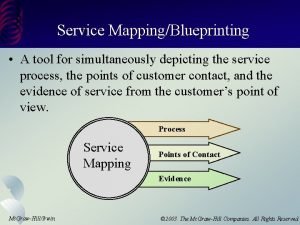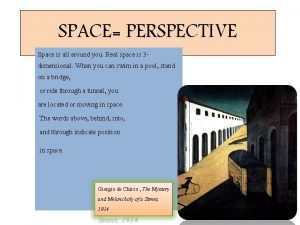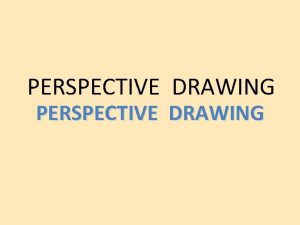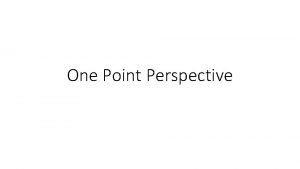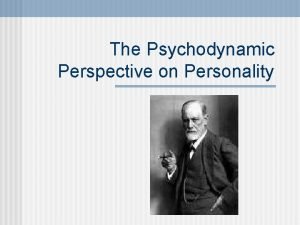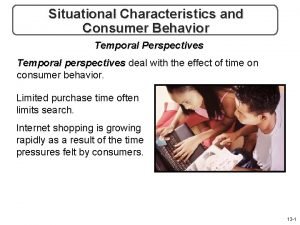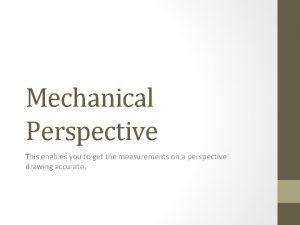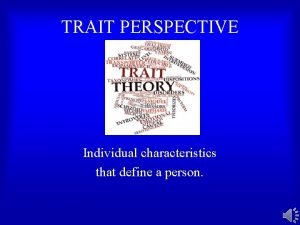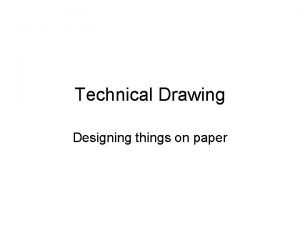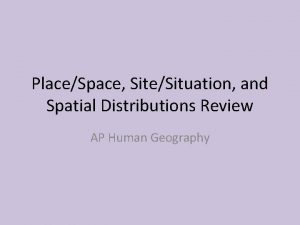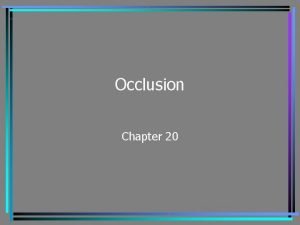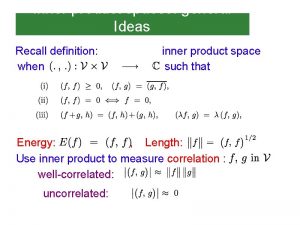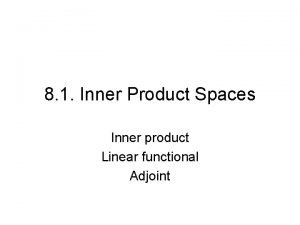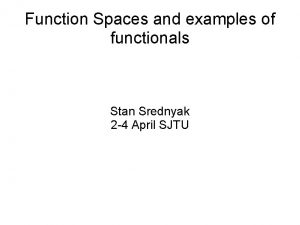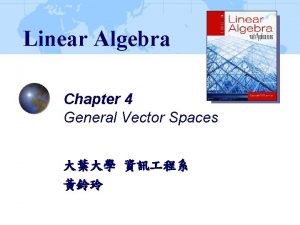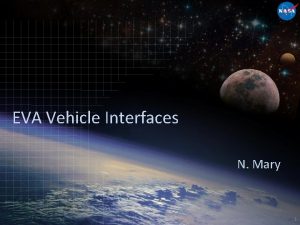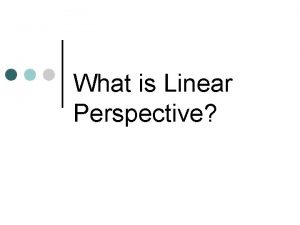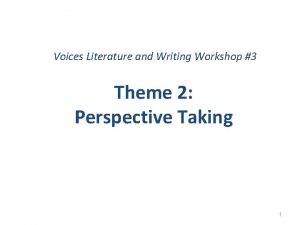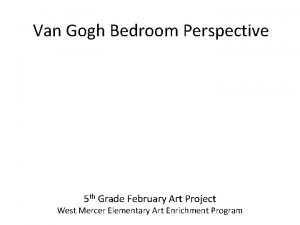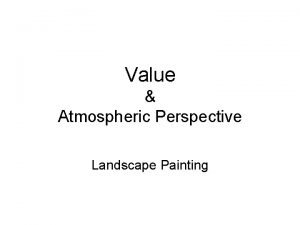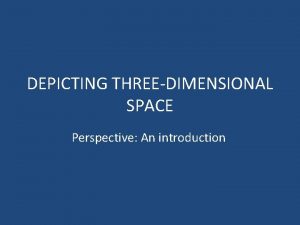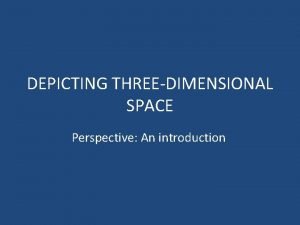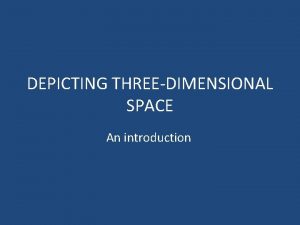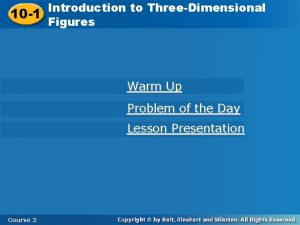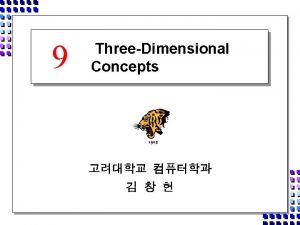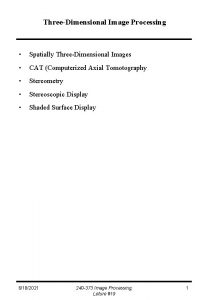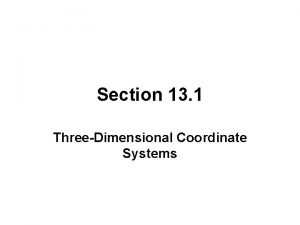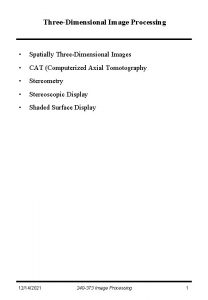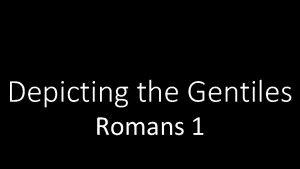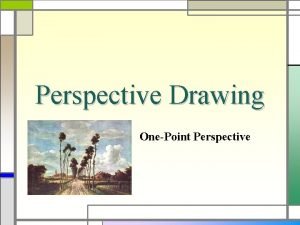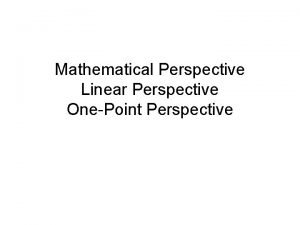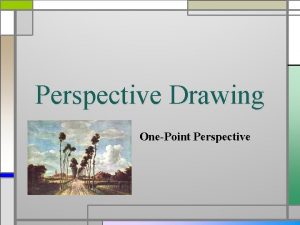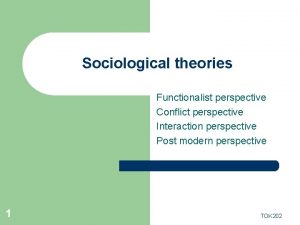DEPICTING THREEDIMENSIONAL SPACE Perspective An introduction SPACE Definition
















































- Slides: 48

DEPICTING THREE-DIMENSIONAL SPACE Perspective: An introduction

SPACE Definition: The illusion of depth & distance. Characteristics: • Overlapping • Diminishing size • Spatial Planes: Objects that are farther away are higher on the page (picture plane) • Atmospheric Perspective • LINEAR PERSPECTIVE

Linear Perspective • The first known paintings done in linear perspective were created in 1425 by Filippo Brunelleschi (1377 – 1446) • Brunelleschi noticed that when he painted the lines of several Florentine buildings in a mirror, they converged at one point along the horizon line.

15 th century : Before Brunelleschi What’s wrong with this picture?

How is this better? Pietro Perugino's usage of perspective in this fresco at the Sistine Chapel (1481 -82) helped bring the Rennaissance to Rome.

A vanishing point is the location where lines converge. Where do the lines converge here?

One vanishing point is typically used for roads, railway tracks, hallways, or buildings viewed from the front and facing the viewer.

One-Point Perspective Exteriors The vanishing point can run from the left, right, or right down the middle.

One-Point Perspective Interiors • Where is the vanishing point in this photo? • How many things in this photo align to one vanishing point?

Horizon Line or Eye-Level Where the ground meets the sky. Often hidden behind walls

Perspective Changes Based on Location on the Picture Plane

Linear Perspective DIRECTIONS

Drawing Boxes: One Point Perspective Vanishing Point Orthagonal Lines

One-Point Perspective Draw a horizon line (eye level)

Add a Vanishing Point

Draw 5 boxes in the following locations: 4 5 3 1 2

Connect the corners of box #1 to the Vanishing Point. These lines are called “converging lines” or orthogonal lines 1

Add lines that are “parallel” to the square’s front 1

Now connect the other boxes to the vanishing point. DO not erase the converging lines: Use a Ruler! 1

You should end up with something like this:


Two-Point Perspective

Two-Point Perspective shows objects as viewed from a corner.

Two-Point Perspective

Two point perspective box (1) above, (2) on, and (3) below eye level. Example of what you will create.

Two point perspective box (1) above, (2) on, and (3) below eye level.

Two point perspective box (1) above, (2) on, and (3) below eye level.

Two point perspective box (1) above, (2) on, and (3) below eye level.

Two point perspective box (1) above, (2) on, and (3) below eye level.

Two point perspective box (1) above, (2) on, and (3) below eye level.

Two point perspective box (1) above, (2) on, and (3) below eye level.

Two point perspective box (1) above, (2) on, and (3) below eye level.

Two point perspective box (1) above, (2) on, and (3) below eye level.

Two point perspective box (1) above, (2) on, and (3) below eye level.

Two point perspective box (1) above, (2) on, and (3) below eye level.

Two point perspective box (1) above, (2) on, and (3) below eye level.

Two point perspective box (1) above, (2) on, and (3) below eye level.

Two point perspective box (1) above, (2) on, and (3) below eye level.

Two point perspective box (1) above, (2) on, and (3) below eye level.

Two point perspective box (1) above, (2) on, and (3) below eye level.

Two point perspective box (1) above, (2) on, and (3) below eye level.

Two point perspective box (1) above, (2) on, and (3) below eye level.

Congratulations you are done!

Two point perspective box (1) above, (2) on, and (3) below eye level. Example of what you will create.

Three-Point Perspective Three-point perspective is typically used for buildings seen from above or below.

The vanishing point typically runs off the page when drawing in this way.

Different Viewpoints:

5 Point Perspective: 5 Point Perspective in a Crystal Ball Video
 A tool for simultaneously depicting the service process
A tool for simultaneously depicting the service process Tales background
Tales background How to draw stairs in 2 point perspective
How to draw stairs in 2 point perspective Silo perspective vs business process perspective
Silo perspective vs business process perspective Space perspective drawing
Space perspective drawing Unscented trajectory chapter 5
Unscented trajectory chapter 5 Space junk the space age began
Space junk the space age began Camera space to world space
Camera space to world space Unscented trajectory chapter 5
Unscented trajectory chapter 5 World space computer
World space computer Strategic perspective meaning
Strategic perspective meaning One point perspective river
One point perspective river One point perspective definition
One point perspective definition Contemporary perspective definition
Contemporary perspective definition What is a formal region
What is a formal region Projection defense mechanism
Projection defense mechanism Temporal state marketing
Temporal state marketing One point perspective from plan and elevation
One point perspective from plan and elevation Legalistic perspective definition
Legalistic perspective definition Individual perspective definition
Individual perspective definition Simple technical drawing
Simple technical drawing Tok religious knowledge
Tok religious knowledge Cognitive perspective definition
Cognitive perspective definition Generalist social worker definition
Generalist social worker definition Essay structure introduction
Essay structure introduction Space in science meaning
Space in science meaning High definition space telescope
High definition space telescope Distance decay example
Distance decay example Overjet occlusion
Overjet occlusion Inner product space
Inner product space Inner product space definition
Inner product space definition Orthogonal complement
Orthogonal complement Non functional space maintainer
Non functional space maintainer Design space definition
Design space definition Political organization of space definition
Political organization of space definition Types of performance space
Types of performance space Function space definition
Function space definition Span of a vector
Span of a vector Confined space definition bc
Confined space definition bc Eva definition space
Eva definition space Third person omniscient clue words
Third person omniscient clue words Holistic perspective in qualitative research
Holistic perspective in qualitative research Psychological perspective
Psychological perspective What is linear perspective
What is linear perspective Perspective taking goals
Perspective taking goals Bedroom perspective
Bedroom perspective Aerial perspective landscape painting
Aerial perspective landscape painting Psychoanalytic theory
Psychoanalytic theory The 7 approaches to psychology
The 7 approaches to psychology
